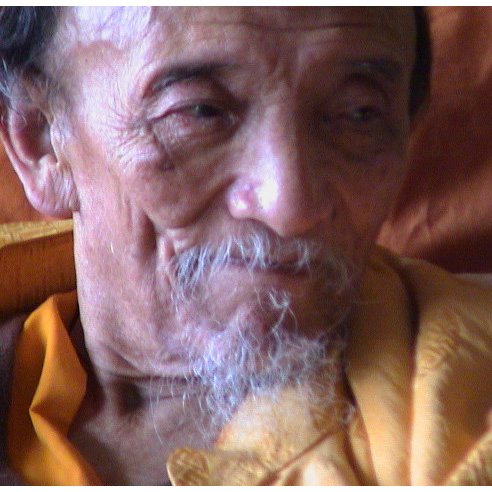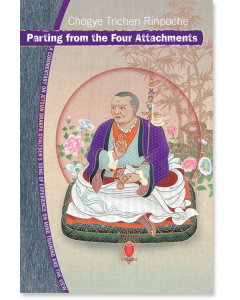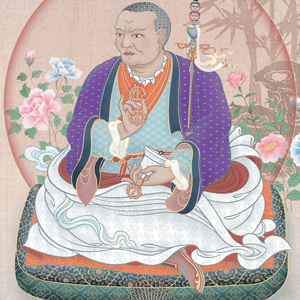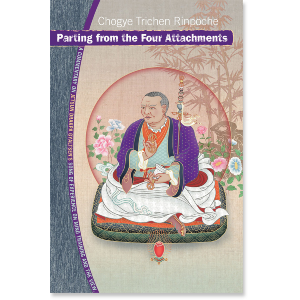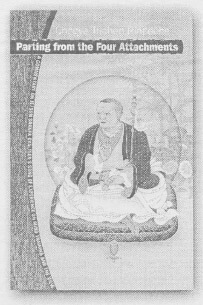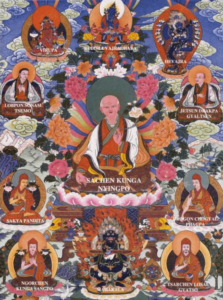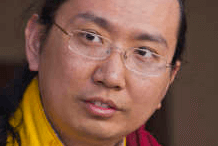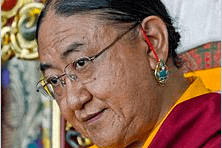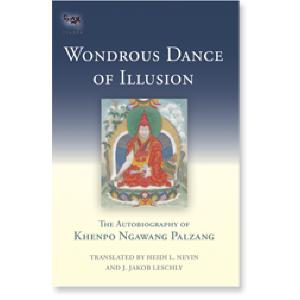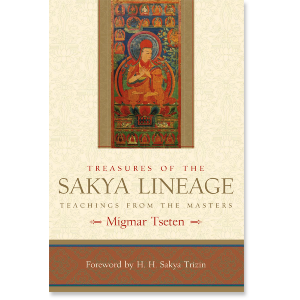| The following article is from the Summer, 2003 issue of the Snow Lion Newsletter and is for historical reference only. You can see this in context of the original newsletter here. |
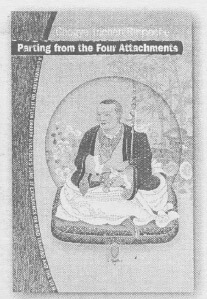
The following excerpts are taken from Parting from the Four Attachments, by Chogye Trichen Rinpoche.
The teaching on the Four Attachments is universally regarded as one of the jewels of Tibetan Buddhism. This detailed and lucid commentary explores the nature of mind, points out inevitable pitfalls in spiritual practice and shows how they can be avoided. Chogye Trichen Rinpoche is a primary teacher of H.H. the Dalai Lama, H.H. Sakya Trizin and many other great lamas.

Those who wish to engage in the authentic Dharma have a great need to hear and understand the instructions on parting from, or freeing oneself from, the four attachments indicated by Manjushri himself. The sincere practitioner may follow these instructions, which will help them to proceed along the path. Remaining true to the spirit of the Dharma means to be neither tarnished nor corrupted by any of the four traps, or four kinds of attachment, revealed by Manjushri. Those who wish to avoid many potential pitfalls need to listen to and be heedful of the meaning of 'Parting from the Four Attachments.'
* * *
This work of Drakpa Gyaltsen is eminently practical, since it actually has the power to instill realizations in the minds of practitioners. It is capable of evoking realization as it is spoken, listened to, and learned. It is for this reason that we will use his precious words to understand the meaning of Manjushri's four-line teaching.
* * *
If you are attached to this life, you are not a person of Dharma.
For those who study with proper intentions, anything they may learn will serve to dispel the darkness of ignorance and confusion they may be experiencing in their own lives. This is because whatever they study, they will apply it to themselves, and this will alleviate the sufferings that afflict them. Anything such people may study will further serve to humble and ennoble them, increasing their clarity and brilliance, their knowledge and wisdom. Genuine study is the basis for attaining enlightenment, a cause for oneself to finally attain the state of dharmakaya, the wisdom body of truth or reality.
* * *
It is said that one who has studied with the mistaken attachment to their welfare in this life alone will look down on those who have not studied as much as they have, rejecting the other persons, ignoring them, even behaving hurtfully toward them. Their knowledge has given them license to belittle others, to find fault with others but never with themselves. These kinds of attitudes are simply due to the person's own sense of insecurity and inferiority, which causes them to disparage others, whether their knowledge may be greater or less than their own. Someone like this will sow seeds of discord and feel that they must try to get people to side with them, fearful that others will not support their opinions.
* * *
Meditation practice not only enables us to remedy the defilements that haunt our minds; it also imparts intelligence and wisdom to our daily activities. Wherever we are, whatever we may do, the strength of mindfulness and watchful alertness that we have developed through meditation creates a beneficial habitual tendency for us. This habituation to mindfulness and watchful noticing gained through meditation is what allows us to transcend all other contrary, conflicting habitual patterns.
Mindfulness and watchfulness awaken intelligence (prajna). With this foundation, we develop the intelligence that is, among other things, able to eliminate the negative side effects we may have accumulated through artificial practice. The development of intelligence gives our minds enough clarity to distinguish what is genuine about our practice and what is not. This intelligence is what re-invigorates our practice, giving us renewed energy and a freshened perspective. With this new perspective, we find ourselves able to perceive many qualities of the Dharma where before we saw only negativity.
* * *
If you meditate while motivated by worldly aims, your mind will do more than just continue to wander about, running here and there whenever you find yourself alone. The minute you again meet other people, you may suddenly discover that you have so much to say, so many things to share, that you are desperate to catch up on anything you might have missed while you were meditating. You will rush into irrelevant conversations with great zeal, just to make up for the deprivation you have suffered through remaining in isolation. You will roam about, in search of conversation.
When you are alone, you will find yourself planning your future dialogues. You will ponder well and choose with great care just those words that give weight to your realization and express its profundity. You will plan methodically how best to entertain and enlighten others with the fruits of your isolation. If you find yourself acting like this, you can be sure that you have remained consistently without any sort of stable mental focus. Regardless of what you may be doing physically, your mind has become more agitated, with more stress and tension than you had before.
* * *
If you are attached to the world of existence you do not have renunciation.
There was a great master, Langtangpa, who was known as the dark-faced one because he never smiled, overwhelmed as he was by the knowledge of the intensity of the suffering of suffering. He wept continuously because not only could he see the suffering of beings, but he could feel it for himself. Through this kind of vivid entry into the suffering of the lower realms, imagining ourselves born in those conditions, we will be able to gain some experience of the suffering of suffering and develop real empathy for the ill-fated ones who find themselves in these realms.
The possibility that we could be there in actuality, physically experiencing such a life, should indeed cause our flesh to tremble in apprehension and fear. If we can give rise to these waves of shock and horror, this is very valuable to the practice of Dharma, as it will engender in us a powerful sense of renunciation. If you truly contemplate the sufferings of worldly existence, there is no time for anything other than tears.
* * *
If you are attached to your own purpose, you do not have Bodhicitta.
While practicing thus, the great exponents of altruism, those who follow the teachings and try to emulate the deeds of the Bodhisattvas, have made prayers and aspirations in accord with these principles. Most essentially, they have prayed:
May the sufferings of all living beings
Of the three realms of existence ripen upon me.
May the merit and virtue that I have earned
Be taken from me and given to other sentient beings.
You must first of all generate this aspiration, making strong wishes and prayers, before you can become capable of actually bringing this about in practice. In order to be able to train yourself through these prayers, you must have the courage to change the quality of your heart, to be truly different, even to be able to recite such prayers. This is because you must be willing to accept your fate, if your prayers actually come true! This is the measure of your practice.
* * *
Not only this, but you must aspire to gather an abundance of merit and happiness, vast enough to actually have something to give to all sentient beings. Then you can wish that all the meritorious deeds you have already accumulated may be taken away and enjoyed by all sentient beings. This aspiration must first be developed through training yourself in prayer. Then, later, if it actually happens that someone takes something of value from you, you will never experience any suffering as a result, since this is exactly what you have prayed for.
* * *
In the present context, we can say that those who have not learned to recognize the true nature of mind, ultimate bodhicitta, are only able to exchange themselves for other beings and to try to eliminate the suffering of others through prayer, visualization, and empathizing with others. However, if one knows how to recognize the true nature of mind, and mixes or merges the exchange of self and others with the recognition of mind nature, this is the best possible way to practice this exchange.
The ultimate awakening of bodhicitta includes the realization that the true nature of all living beings is utterly free from all the varieties of temporary, conceptual confusion that normally deludes them. In fact, all beings share the true nature of phenomena (dharmata), which is emptiness. All beings have awareness-wisdom (rigpa'i yeshe), the luminous clear light of the nature of reality. The true nature of all living beings is the expanse of primordial purity (kadag ying). This essence is present in all living beings, and it never leaves them, but they fail to recognize it. Recognizing it is the ultimate awakening of bodhicitta.
* * *
If grasping arises, you do not have the view.
One who discovers the key point that mind is the cause of all problems and all solutions learns to unlock, to disentangle, all things associated with the mind. In the end, one finds no other culprit. Mind is the perpetrator of everything that happens, the projector of everything that manifests. Pleasant or unpleasant, whether we go up into higher rebirth of down to the lower realms, whatever we experience is the result of our own mental state. Realizing this, we should no longer grasp at any perception or conception that might arise toward seemingly real phenomena.
The phrase "the unity of clarity and emptiness" (sal long zungjug) is a special term for the view favored by the Sakya tradition. If you care to observe your perceptions, you will find that whatever you perceive and whatever you experience is the reflection of these three: clarity, emptiness, and their unity. This is what is meant by the unity of clarity and emptiness, and this is what you must realize. To realize this is to realize the true nature (dhamiata) of the Buddhas.
There are many similar terms, such as "the unity of appearances and emptiness" (nang long zung jug). Things do appear, but when you examine them in meditation, you discover that they are empty of any inherent existence. Also, we may speak of the unity of sound and emptiness or "audible" emptiness (drak long zung jug). Everything that we hear, if examined, is found to be empty. In this case, emptiness is discovered and established through hearing sounds, which are not inherently present by themselves.
* * *
As we have said, when the last thought has ceased, and the next thought has not yet arisen, there is a gap. In this gap your mind is not like a blank space, as there is some experiencing or knowing present. When recognized, this is luminosity (osal); it is also known as self-knowing primordial wisdom, or simply as awareness(rigpa). This awareness is a non-dual continuity.
Whether one speaks of dzogpa chenpo, mahamudra, or khorde yerme, there is nothing beyond just this; there is nothing more to be discovered. Now, once you have recognized awareness (rigpa) it is necessary to remain in that state. It is not enough simply to recognize, you must continue on in the recognition. In order to be able to do so, you must receive the transmission and guidance of a genuine master and the blessings of an authentic lineage. This continuity in the recognition of awareness is the real meaning of the inseparability of samsara and nirvana; it is the great seal (mahamudra); it is the great perfection (dzogchen).

